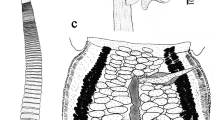Abstract
Proctocaecum gairhei n. sp. is described from the gharial Gavialis gangeticus (Gmelin) in Nepal. The new taxon can be distinguished from all other species of Proctocaecum Baugh, 1957 by the combination of the following morphological characters: a single row of 23 cephalic spines, lateral anal pores opening at uneven levels, a forebody accounting for 16% of the total body length (TBL), an oral to ventral sucker width ratio of 1:0.7, an oral sucker to pharynx width ratio of 1:0.6 and uterine loops that occupy 59–67% of the TBL. While sharing some morphological characteristics with Acanthostomum slusarskii Kalyankar, 1977 from Crocodylus palustris (Lesson) in India, P. gairhei n. sp. is distinguished from the latter by possessing the solid muscular gonotyl diagnostic for Proctocaecum, by the number of cephalic spines, position of the anal pores and egg size. The existing cladogram for Proctocaecum was expanded using the character information of P. gairhei n. sp. The host range of Proctocaecum is now known to include all three families of the order Crocodylia.


Similar content being viewed by others
References
Brooks, D. R. (1980). Revision of the Acanthostominae Poche, 1926 (Digenea: Cryptogonimidae). Zoological Journal of the Linnean Society, 70, 313–382.
Brooks, D. R. (2004). Comments on the gonotyl of Proctocaecum macroclemidis (Tkach and Snyder, 2003) n. comb. (Digenea: Acanthostomidae: Acanthostominae), with a key to the genera of Acanthostominae and a new phylogenetic tree for Proctocaecum Baugh, 1957. Journal of Parasitology, 90, 594–597.
Brooks, D. R., & Holcman, B. (1993). Revised classification and phylogenetic hypothesis for the Acanthostominae Looss, 1899 (Digenea: Opisthorchiformes: Cryptogonimidae). Proceedings of the Biological Society of Washington, 106, 207–220.
Brooks, D. R., & McLennan, D. A. (1993). Parascript, parasites and the language of evolution (429 pp). Washington, DC: Smithsonian Institution Press.
Catto, J. B., & Amato, J. F. R. (1993). Digenetic trematodes (Cryptogonimidae, Acanthostominae) parasites of the Caiman, Caiman yacare (Reptilia, Crocodylia) from the Pantanal Mato-Gossense, Brazil, with the description of a new species. Memórias do Instituto Oswaldo Cruz, 88, 435–440.
Foggin, C. M. (1992). Diseases of farmed crocodiles. In G. A. Smith & J. Marias (Eds.), Conservation and utilization of the Nile crocodile in Southern Africa. Handbook on crocodile farming (pp. 107–140). Pretoria: The Crocodile Study Group of Southern Africa.
Gairhe, K. P. (2007). An investigation on the causes of mortality in captive gharial hatchlings at the Chitwan National Park, Nepal. Dissertation, Tribhuvan University.
Kalyankar, S. D. (1977). Acanthostomum slusarskii sp. n. (Trematoda, Acanthostomidae) from Crocodilus palustris Less in India. Acta Parasitologica Polonica, 24, 227–230.
Lamothe-Argumedo, R., & Ponciano-Rodríguez, G. (1985). Revision de la subfamilia Acanthostominae Nicoll, 1914 y establecimiento de dos nuevos generos. Anales del Instituto de Biología, Serie Zoología, Universidad Nacional Autónoma de México, 56, 301–322.
Moravec, F. (2001). Some helminth parasites from Morelet’s crocodile, Crocodylus moreletii, from Yucatan, Mexico. Folia Parasitologica, 48, 47–62.
Pérez Benitez, I., Sardinas, G., & Benitez, A. (1980). Hallazgo y evolución de una parasitosis aguda producida por Acanthostomum loossi Pérez Vigueras, 1956 en animales jóvenes de una cría industrial de crocodilos (Crocodylus acutus Cuvier y Crocodylus rhombifer Cuvier). Revista Cubana de Ciencias Veterinarias, 11, 79–83.
Roopa, T. M., & Janardanan, K. P. (1998). The life cycle of Acanthostomum burminis (Trematoda, Acanthostomidae). Acta Parasitologica, 43, 189–193.
Scholz, T., Vargas-Vásquez, J., Moravec, F., Vivas-Rodríguez, C., & Mendoza-Franco, E. (1995). Metacercariae of trematodes of fishes from cenotes (= sinkholes) of the Yucatan Peninsula, Mexico. Folia Parasitologica, 42, 173–192.
Tkach, V. V., & Snyder, S. D. (2003). Acanthostomum macroclemidis n. sp. (Digenea: Cryptogonomidae: Acanthostominae) from the Alligator snapping turtle, Macroclemys temmincki. Journal of Parasitology, 89, 159–167.
Acknowledgements
We are indebted to Dr K. P. Gairhe, Chitwan National Park, Nepal, for making the specimens available to us, and to Dr F. W. Huchzermeyer, South Africa, Crocodile Specialist Group, SSC, IUCN, for facilitating the specimen transfer. The research was made possible by a post-doctoral fellowship awarded to the first author by the University of Pretoria, South Africa.
Author information
Authors and Affiliations
Corresponding author
Rights and permissions
About this article
Cite this article
Junker, K., Brooks, D.R. & Boomker, J. Proctocaecum gairhei n. sp. (Digenea: Cryptogonimidae: Acanthostominae) from Gavialis gangeticus (Gmelin) in Nepal and a revised cladogram of Proctocaecum Baugh, 1957. Syst Parasitol 71, 229–236 (2008). https://doi.org/10.1007/s11230-008-9151-9
Received:
Revised:
Accepted:
Published:
Issue Date:
DOI: https://doi.org/10.1007/s11230-008-9151-9




